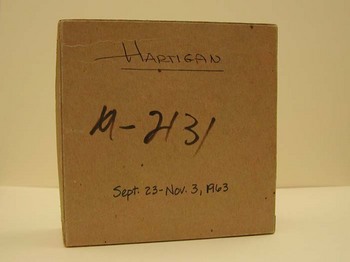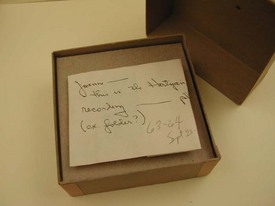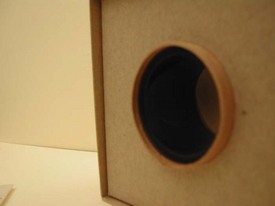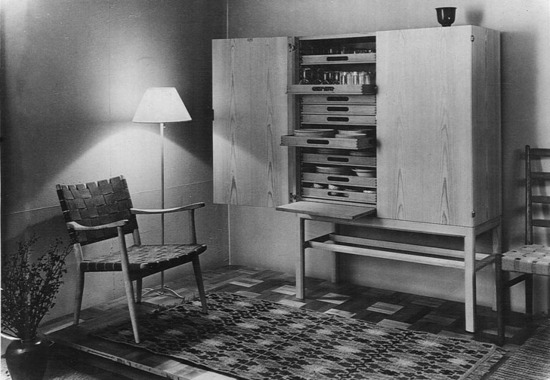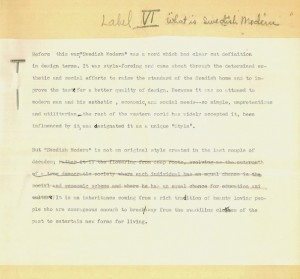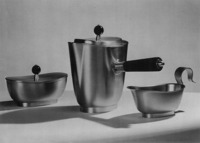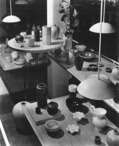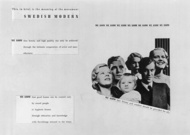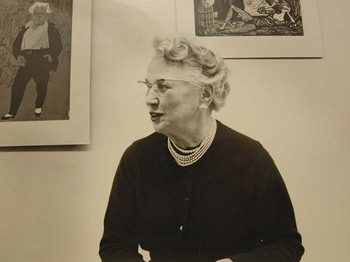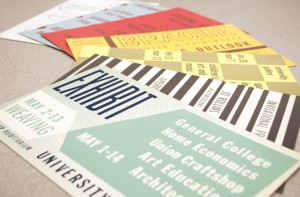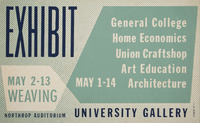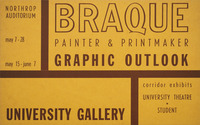In 1959, the University Gallery hosted a Japanese flower-arranging demonstration in conjunction with the exhibition “Japanese Prints”, and I discovered this contact sheet documenting the event in the files. I love contact sheets, since they show every shot the photographer took on that roll, prior to editing.
2011
Mysterious Media
Though a majority of processing has consisted of rhythmic re-foldering, several boxes have also contained mysterious miscellany found amongst the folder sets…
After removing each of the two folders containing materials for the Grace Hartigan Exhibition, (held at the University Gallery from Sept. 23 – Nov. 4, 1963), an item, which had been shoved underneath the folders, was revealed at the bottom of the box: a smaller cardboard box!
Labeled with “Hartigan” and the dates of the exhibition, the box was obviously intended to be included with this folder set. The contents of the box create further intrigue…
A small note that states, “Joanne – this is the Hartigan tape recording – please ‘file; (ex: folder), 63-64, Sept. 23 – Nov. 3,” covered the small reel of tape that rested inside. After consulting with the advising archivist, the box was made note of and set aside for further investigation.
What is this mysterious media?
Swedish Modern
Most of the exhibition files from the late 1930s and early 1940s do not have photographs in them, but when they do, these images give a window into the times. This Swedish Arts and Crafts exhibition from 1944 actually still feels quite modern (I’m looking at you, IKEA). Some of the wall label drafts for the show are also quite interesting — Label IV reads:
Before the war, “Swedish Modern” was a word which had a clear cut definition in design terms. It was style-forming and came about through the determined esthetic (sic) and social efforts to raise the standard of the Swedish home and to improve the taste for a better quality of design… But “Swedish Modern” is not an original style created in the last couple of decades. It is an inheritance coming from a rich tradition of beauty loving people who are courageous enough to break away from the swaddling clothes of the past to entertain new forms for living.
Candid
Creating space, expanding place
Processing the WAM collection allows for direct exposure to the documentation of institutional history. Contained within the third box of the WAM collection is a folder titled, “Biennial Report to President, 1947-1948.” The contents consist simply of four delicately aged pages, on which is contained a draft composed by then University Gallery director Ruth Lawrence. The draft opens with Lawrence acknowledging that the Gallery has “completed 15 years of service to the University. At such a milestone we would like to pause long enough to revise and make appraisal of our position and record what has been accomplished.”
Lawrence continues to describe the accomplishments of the Gallery, notes the success of the W.P.A. program in conducting gallery programming, and lists the number of various art forms and works in the permanent collection, as well as the individuals and organizations that had donated them.
On the final page of the draft, Lawrence asserts a serious appraisal of position in regards to the state of Gallery facilities:
“The Gallery is located on the 4th floors of Northrop in an inaccessible place. Many interested visitors cannot or will not climb the four flights of stairs. There is no elevator for such people nor any way of getting our exhibitions up to the Gallery except by carrying everything by hand. This entails making many trips daily. Certainly it is not only a waste of time but of valuable energy for all of us. There is no adequate storage space and our materials are spread into 12 rooms on the various levels of this huge building. With this allotment of funds this year, however, there will be improvements through consolidating most of our activity on the 3rd and 4th floors. For relatively a short period only can this growth for strength in the arts go on without our being stunted for lack of physical space. It hampers all our activity even now. Thus in any plans which are being made for more building by the University we fervently urge that we be included.”
As major construction will soon be accomplished on the current WAM expansion, I can’t help but wonder how Lawrence would appraise the position of art at the University today… Her dedication to creating space and expanding a place for art at the U of M has certainly echoed throughout University history and is demonstrated by it’s continued “growth for strength in the arts.”
Note: The University Archives holds a separate and unique collection titled, University Gallery Records, which was accessioned in 1957 and 1961. View the finding aid for historical notes, as well as a description of the records that document the Gallery.
Vintage Posters
While going through the University Gallery files from the early 1950s, we found many small posters (7″x11″) for the exhibitions, no doubt to post around campus. These posters are one-color prints (sometimes on a colorful paper stock) with no images, but with some simple graphic flourishes–they are very charming in their simplicity. I can definitely see echos of this kind of straightforward design in today’s graphic design trends. We thought we’d share a few of these gems!
Ready, set… Process!
It has begun. On Tuesday, February 8th, project processors Areca and Rebecca, U of M graduate students, and Weisman Art Museum interns, began processing the Frederick R. Weisman Art Museum records contained within the University Archives. We’ve pushed up our glasses, rolled up our sleeves, advanced the lead on our mechanical pencils… and have begun re-foldering, re-boxing, and recording boxes within the collection containing materials that span from the late 1930s to the mid 1960s.
What exactly does processing entail? University Archivist, Erik Moore, the University Archives project adviser, introduced both Areca and Rebecca to standard procedures for archival processing, which we will continue to learn as well as share along the way.
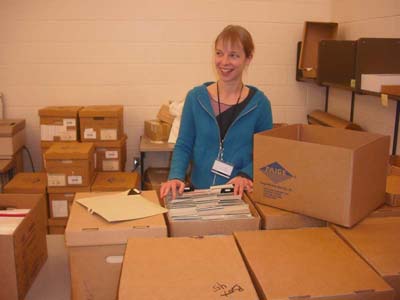
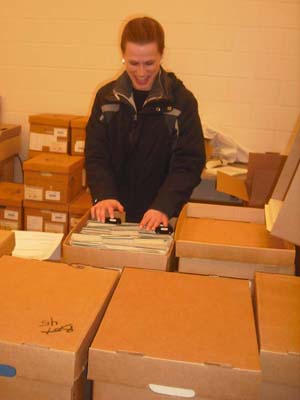
About:
Since October 2010, The Weisman Art Museum has been closed to the public in order to complete a $14 million expansion project, to include four new galleries to showcase the permanent collection, a café cart, and an additional gallery space, the Target Studio for creative collaboration. Behind closed doors, WAM has been working on another “building” project that doesn’t require hard hats, tool belts or the qualifications to operate heavy machinery, but that does require a keen eye to detail, patience for repetition, and an organizational fortitude – the construction of the WAM Archives.
WAM Exhibition staff and archivists from the University Archives have collaborated to process over 180 boxes of archival material transferred to the Archives from WAM in a series of accessions that occurred between 1997 and 2009. The material, which begins in the 1930’s when WAM was first known as the University Gallery and guided by the director, Ruth Lawrence, also covers the restructuring and adjustment to the title of University Art Museum, and additionally records the planning and correspondence related to the museum’s move from a few rooms in Northrup Auditorium, to the internationally known Frank Gehry designed Weisman, under the leadership of current director Lyndel King, in the 1990s. Exhibits mounted, programs held, and activities pursued within this time span are represented within the boxes stored amidst the caverns of the University Archives in Andersen Library. This project will document, preserve, and make accessible the unique institutional history of the University of Minnesota’s art museum.
After completion of this first component, WAM will fine-tune it’s own policies and develop a guide for records management practices to ensure that materials created in the production of exhibits (such as the 2007 Bob Dylan exhibit) and other programs, events and administrative processes currently stored at WAM, are transferred regularly to the University Archives to be made accessible for all interested parties in the history of the Frederick R. Weisman Art Museum at the University of Minnesota.

